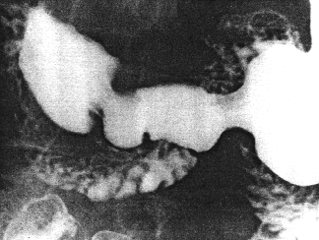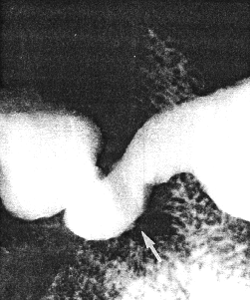


Go to chapter: 1 | 2 | 3 | 4 | 5 | 6 | 7 | 8 | 9 | 10 | 11 | 12 | 13 | 14 | 15 | 16 | 17 | 18 | 19 | 20 | 21 | 22 | 23 | 24 | 25 | 26 | 27 | 28 | 29 | 30 | 31 | 32 | 33 | 34 | 35 | 36 | 37 | 38 | 39
Chapter 20 (page 93)




Go to chapter: 1 | 2 | 3 | 4 | 5 | 6 | 7 | 8 | 9 | 10 | 11 | 12 | 13 | 14 | 15 | 16 | 17 | 18 | 19 | 20 | 21 | 22 | 23 | 24 | 25 | 26 | 27 | 28 | 29 | 30 | 31 | 32 | 33 | 34 | 35 | 36 | 37 | 38 | 39
Chapter 20 (page 93)
 |
Fig. 20.4. Case J.P.W. Spasm of pyloric sphincteric cylinder. Gastroscopy revealed no organic lesion |
Case 20.5. H.O., 69 year old female, a known case of polycythaemia vera, splenomegaly, hepatomegaly and cholelithiasis, underwent cholecystectomy at which the stomach was proved to be normal. Because of a feeling of fullness in the epigastrium an upper gastrointestinal barium series was requested 10 days post-operatively. There was a persistent contraction of the pyloric sphincteric cylinder; occasionally it contracted maximally but never relaxed more than illustrated (Fig. 20.5). Normal cyclical contractions of the cylinder at 3 per minute were absent. The partial contraction of the cylinder fixed the pyloric aperture in the open position; at times duodenogastric reflux occurred through the patent pyloric aperture and contracted cylinder (Chap. 27). The contraction was associated with a concave impression of the base of the duodenal bulb. In view of the absence of an organic gastric lesion at operation, the condition was diagnosed as simple spasm of the pyloric sphincteric cylinder.
 |
Fig. 20.5. Case H.O. Spasm of pyloric sphincteric cylinder. Pyloric aperture fixed in patent position. Intermittent duodenogastric reflux. No gastric lesion detected at cholecystectomy |
Case 20.6. W.J.G., 76 year old female was referred for radiographic studies because of loss of appetite. There was partial contraction of the pyloric sphincteric cylinder throughout the examination with absence of normal cyclical activity (Fig. 20.6). A prominent circumferential mucosal fold in the contracted cylinder raised the possibility of associated gastritis (Chap. 28). Gastroscopy showed no abnormality; it was noted that the pyloric aperture remained patent. At control barium studies a fortnight later the contraction had disappeared and normal cyclical activity was seen. The initial appearance was diagnosed as spasm of the pyloric sphincteric cylinder.
 |
Fig. 20.6. Case W.J.G. Contracted pyloric sphincteric cylinder with prominent mucosal fold (arrow). Gastroscopy showed no organic lesion |
Previous Page | Table of Contents | Next Page
© Copyright PLiG 1998